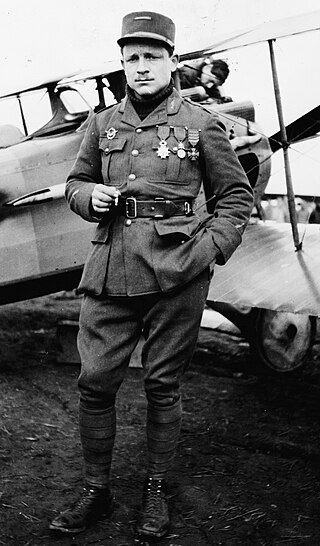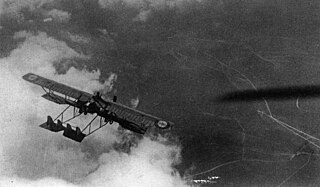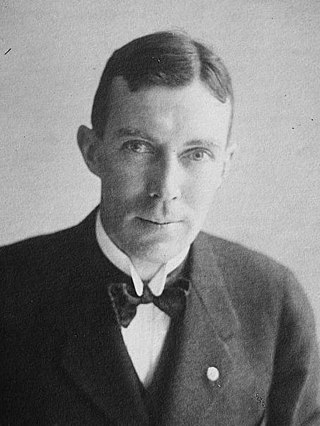
The La Fayette Escadrille was the name of the French Air Force unit escadrille N 124 during the First World War (1914–1918). This escadrille of the Aéronautique Militaire was composed largely of American volunteer pilots flying fighters. It was named in honor of the Marquis de Lafayette, French hero of the American Revolutionary War. In September 1917, the escadrille was transferred to the United States Army under the designation 103rd Aero Squadron. In 1921, the French Air Force recreated a N124 unit who claimed lineage from the war-time La Fayette escadrille and is now part of the escadron 2/4 La Fayette.

The SPAD S.XIII is a French biplane fighter aircraft of the First World War, developed by Société Pour L'Aviation et ses Dérivés (SPAD) from the earlier and highly successful SPAD S.VII.

Eugene Jacques Bullard was one of the first African-American military pilots, although Bullard flew for France, not the United States. Bullard was one of the few black combat pilots during World War I, along with William Robinson Clarke, a Jamaican who flew for the Royal Flying Corps, Domenico Mondelli from Italy, and Ahmet Ali Çelikten of the Ottoman Empire. Also a boxer and a jazz musician, he was called "L'Hirondelle noire" in French.

Gervais Raoul Victor Lufbery was a French and American fighter pilot and flying ace in World War I. Because he served in both the French Air Force, and later the United States Army Air Service in World War I, he is sometimes listed alternately as a French ace or as an American ace. Officially, all but one of his 17 combat victories came while flying in French units.

The Deutsche Luftstreitkräfte – known before October 1916 as Die Fliegertruppen des deutschen Kaiserreiches – was the air arm of the Imperial German Army. In English-language sources it is usually referred to as the Imperial German Air Service, although that is not a literal translation of either name. German naval aviators of the Marine-Fliegerabteilung were an integral part of the Imperial German Navy. Both military branches operated aeroplanes, observation balloons and airships.
Friedrich Wilhelm "Fred" Zinn was a volunteer American aviator of German descent who flew with French Armée de l'Air forces in World War I and an early pioneer of aerial photography for wartime reconnaissance and Military intelligence.

William Augustus Wellman was an American film director, producer, screenwriter, actor and military pilot. He was known for his work in crime, adventure, and action genre films, often focusing on aviation themes, a particular passion. He also directed several well-regarded satirical comedies. His 1927 film, Wings, was the first film to win an Academy Award for Best Picture at the 1st Academy Awards ceremony.

The Lafayette Flying Corps is a name given to the American volunteer pilots who flew in the French Air Force during World War I. It includes the pilots who flew with the bona fide Lafayette Escadrille squadron.

The Caudron G.4 is a French biplane with twin engines, widely used during World War I as a bomber. It was designed by René and Gaston Caudron as an improvement over their single-engined Caudron G.3. The aircraft employed wing warping for banking. The first G.4 was built in 1915, and it was manufactured in France, England and Italy. It was the world's first twin-engine aircraft to be widely used, starting in March 1915.

Major David McKelvey Peterson was a 1915 Lehigh University graduate who became a World War I flying ace. He achieved six aerial victories, one of which was earned in the Lafayette Escadrille; five were officially credited during his tenure with the United States Army Air Service.

Sergeant Austen Ballard Crehore, was a World War I pilot in the Armée de l'Air and the recipient of the Legion of Honor and Croix de Guerre with two palms.

Lieutenant Colonel Georges Thenault was the commander of the Lafayette Escadrille – the famed branch of the French air force in World War I composed of American volunteer pilots. The Lafayette Escadrille was created before the United States gave up its neutrality and joined France and Britain in the war against Germany. Once the United States formally entered the war, the Lafayette Escadrille was absorbed into the U.S. Army.
Sous-lieutenant André Jean Louis Barcat was a French World War I flying ace credited with five aerial victories.
Capitaine Jacques Raphaël Roques was a Swiss citizen who flew for the French during World War I, where he was credited with five aerial victories. He returned to military service during World War II, and served with the French Resistance from the fall of France to war's end.

Adjutant James Alexander Connelly Jr. was a World War I flying ace credited with seven aerial victories.

The 103rd Aero Squadron was an aviation pursuit squadron of the U.S. Air Service that served in combat in France during World War I. Its original complement included pilots from the disbanded Lafayette Escadrille and Lafayette Flying Corps. One of those pilots, Paul F. Baer, became the first ace of an American unit in World War I.

Franklin D'Olier was an American businessman who served as the first national commander of The American Legion from 1919 to 1920. He was also the great-grandfather of actor Christopher Reeve.
Arthur Bluethenthal, nicknamed "Bluey", was an All-American football player for Princeton University, who died in combat fighting for France in World War I.

Martial Henri Valin was a French Air Force general. He initially served as a cavalryman in the First World War. After nine years cavalry service in the chasseurs d'Afrique, dragoons, spahis, and hussars, he eventually volunteered for the French Army's aviation branch, the aéronautique militaire, in 1926. He commanded the Free French Air Forces from July 1941 to June 1944, and was then Chief of General Staff of the French Air Army from October 1944 until 1946. He participated in both World Wars and the Rif War.














